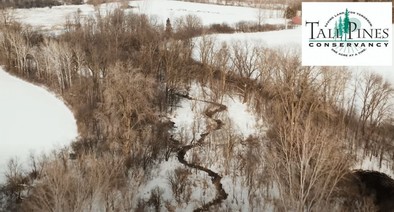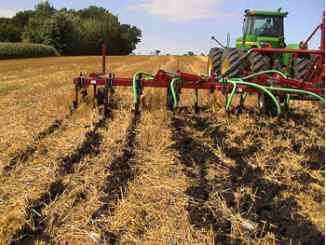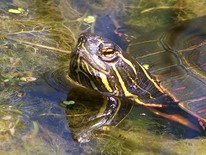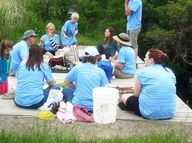 The Mason Creek project features a major channel restoration, and includes wetland scrapes for water quality benefits, in addition to new backwater areas for juvenile fish along this designated Class I Cold Water Trout Stream.
Tall Pines Conservancy was successful in a obtaining a significant grant through the Targeted Run Off Management (TRM) Grant program with the Wisconsin DNR. This grant will be used to help support a much anticipated stream restoration project on Mason Creek. The stream restoration project on conservation land (formerly part of the Schmidt family land) along Mason Creek will re-meander approximately 1,600 feet of a channelized and degraded portion and replanting a 100-foot native riparian corridor.
North Lake Management District, Tall Pines Conservancy, and the Oconomowoc Watershed Protection program have been actively pursuing the design and implementation of a re-meander project on Mason Creek to address water quality concerns in North Lake and the Watershed as a whole. Read more...
Sector Team Updates

Due to the Pandemic, a number of the North American Manure Expo educational sessions have been modified to use a virtual webinar format. This series (Manure Mondays) is an excellent free opportunity to hear from manure experts in the US and Canada on the latest research and trends.
Manure Mondays continues where the Manure Expo left off and provides the opportunity to share new technology and information about managing manure. A series of educational sessions will be presented by OMAFRA and NAME (North American Manure Expo). Registration is free and includes access to all sessions. Sessions will run Mondays from November 8 to March 21, 2022 from 2 – 3 pm (ET). Please note that all webinar events will be recorded.
Clark View Farms is a dairy and crop operation situated in northwest Grant County, in the hills and river boiioms around Bagley, Wisconsin. The current operators of Clark View Farms are Brad, Brian and Bruce Clark, 3 brothers that took over the operation from their parents. This family operation started with the Clark’s grandfather and 30 dairy cows. They now milk 1,000 cows and run nearly 2,100 acres of crop ground.
Clark View Farms started their partnership with NRCS through the Environmental Quality Incentives Program, completing a waste storage facility, waste transfer system and nutrient management. After the initial success of those conservation projects, they decided to go all in on implementing various soil health practices, including no-till planting into living cover crops.
|

January 6-7, 2022, the Algal Bloom Action Team is hosting a free Virtual Harmful Algal Bloom Research Symposium. Last year’s event brought together over 890 educators and researchers from across the US to hear the latest HAB research and discussed ongoing outreach efforts.
This year’s symposium will feature emergent harmful algal bloom (HAB) research and provide a venue for moderated discussions regarding HAB research, outreach, and how information dissemination can be improved. We have 16 cutting edge HAB research presentations lined up focusing on four different topics:
- HAB Monitoring and Ecology
- Cyanotoxin Treatment and Detection
- Forecasting and Modeling HABs
- Emerging Technology for Detecting and Monitoring HABs
This event is free, but registration is required. More information, including a detailed agenda is forthcoming. Stay tuned!
REGISTER HERE
The North Central Region Algal Bloom Action Team was formed in 2018 to and is comprised of representatives from Extension and the Water Resources Research Institutes at each of the land-grant universities within the North Central Region. Collectively, the team is working to make emergent HAB research accessible to agriculture and natural resource educators across the region. As a part of this work, the team is once again hosting a Virtual Harmful Algal Bloom Research Symposium!
|

by: Mia Meister, Washington & Waukesha Counties AIS
There are 8 crayfish species found in Wisconsin. Of the 8, the rusty and red swamp crayfish are the 2 invasive species. It is important for boaters and concerned citizens to take action against these invasive freshwater crustaceans.
Characteristics
- Rusty-colored spots on each side of their back.
- Large, smooth claws are known to range from grayish green to reddish brown.
- Black rings at the end of their claws.
How Rusty Crayfish Became Invasive
- Rusty crayfish are believed to have spread in Wisconsin mainly from fisherman using them as bait.
- They can spread from people dumping aquariums into lakes and rivers.
- Teachers can unknowingly spread invasive crayfish by using crayfish in classrooms and then releasing them into the wild.
- They are a very aggressive species, so predators often do not eat them.
- These crayfish reproduce quickly, and females lay between 80-575 eggs.
Adverse Effects
- Rusty crayfish are opportunistic feeders, meaning they consume almost anything they can get their claws on.
- Erosion increases and water quality decreases due to aquatic plants being depleted.
- Invasive aquatic plants such as Eurasian watermilfoil increase when rusty crayfish uproot native plants.
- Rusty crayfish are harmful to fish spawning areas and reduce shelter for native species.
Preventative Steps
- Do not dump aquarium species into lakes, ponds and streams
- Do not use crayfish as bait (it is against WI law).
- Throw unwanted bait in the trash.
- Inspect your boat and remove all attached aquatic plants, animals, and mud before leaving a boat launch.
- Drain all water from your boat and equipment.
|

The MS4 General Permit is being modified and was public noticed November 1. The general permit is being modified to update the total suspended solids wasteload allocation (WLA) in Appendix A Table A2 for the Lower Fox River Main Stem subbasin. Green Bay Packaging, a paper making facility located within the Lower Fox River Basin TMDL, has ceased its direct discharge to the Fox River and is rerouting its process wastewater to the Green Bay Metropolitan Sewerage District (NEW Water) for treatment. The WLA for total suspended solids has been transferred to the City of Green Bay’s MS4 permit and the WLA for total phosphorus has been transferred to NEW Water under their wastewater WPDES permit. As a result of the transfer, the percent total suspended solids reduction necessary to meet the City of Green Bay’s MS4 WLA in the Lower Fox River Main Stem is changing from 72% to 70.4% in Table A2 of the modified permit. For more information, see the DNR’s WPDES Permits On Public Notice web page.
|

Public notices are required by law to alert interested members of the public of the DNR's intention to authorize a Wisconsin Pollutant Discharge Elimination System (WPDES) discharge to a water of the state. The notices are posted here on the DNR website for 30 days and are also published once in the legal notices section of the local newspaper in the vicinity of the facility. The notice identifies the facility by name, indicates where the discharge is located and briefly describes the facility's activities.
Public Comments Procedure
The public notice document explains how to get more information or comment on the proposed permit action. A member of the public may submit written comments or request that the department hold a public informational hearing. For comments or requests to be timely, they must be submitted within 30 days from the date of public notice, unless otherwise indicated in the notice.
Public participation is detailed in NR 203, Wis. Adm. Code.
|

Applications due Jan 25, 2022
Call for Proposals
The Five Star and Urban Waters Restoration Program focuses on the stewardship and restoration of coastal, wetland and riparian ecosystems across the country. Its goal is to meet the conservation needs of important species and habitats, providing measurable and meaningful conservation and educational outcomes. The program requires the establishment and/or enhancement of diverse partnerships and an education/outreach component that will help shape and sustain behavior to achieve conservation goals.
Funding priorities for this program include:
- On-the-ground wetland, riparian, in-stream and/or coastal habitat restoration
- Meaningful education and training activities, either through community outreach, participation and/or integration with K-12 environmental curriculum
- Measurable ecological, educational and community benefits
- Partnerships: Five Star projects should engage a diverse group of community partners to achieve ecological and educational outcomes.
To date, the Foundation has funded more than 1,000 projects in 50 states, including the District of Columbia, Puerto Rico and the U.S. Virgin Islands through this program. More than $25 million in grants has leveraged more than $81 million in other funds or donated services.
|
|